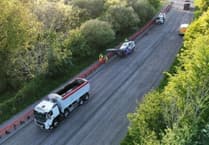CORNISH beaches were among the worst hit in the country for pollution last week.
The Surfers Against Sewage (SAS) Safer Seas service gave a pollution risk warning (where reduced water quality is likely) for Readymoney Cove in Fowey, Polkerris, Par, and East Looe. Meanwhile, Seaton Beach was issued with a pollution alert on August 17 and 18. A pollution alert is described by SAS as when “storm sewage has been discharged from a sewer overflow within the past 48 hours.”
The Cornish-based UK environmental charity described “horrific but unsurprising” sights as “sewage spewed into waterways around the country” after heavy rainfall.
Water companies say that the storm sewer discharges should not be described as “raw sewage” and say that what comes out of the pipes is between 95-97% rainwater.
But this is not much comfort to regular sea swimmers in South East Cornwall who say they have been confronted with plastic bags and other rubbish following heavy rain.
The health risks of swimming in water contaminated with untreated sewage include viral sore throat and cold symptoms, vomiting and diahorreah, skin, ear, and eye infections, E-Coli, and Hepatitis.
“Every year we track thousands of sewage spills at some of England and Wales’s best-loved beaches,” said CEO at Surfers Against Sewage Hugo Tagholm. “Water companies are routinely using our rivers and beaches as a sewage dumping ground, compromising the health of the environment and people alike.”
In a response to SAS, South West Water said that storm drain discharges were used in order to prevent sewage from backing up into homes and businesses. After periods of dry weather, says the utility company, the ground cannot soak up heavy rainfall, leading to the risk that pipes carrying storm water may overflow. Under EU law, storm sewage discharges are legal in “exceptional circumstances” but in 2020 and 2021 there were nearly 400,000 such discharges around the UK. SWW says that all of its intermittent discharges have been deemed to be operating within consent. The company says: “Stormwater overflows are essential features of older combined sewer systems, mainly constructed before 1970, when it was common practice for foul sewage and surface water to be collected in the same pipe.”




.jpeg?width=209&height=140&crop=209:145,smart&quality=75)
Comments
This article has no comments yet. Be the first to leave a comment.